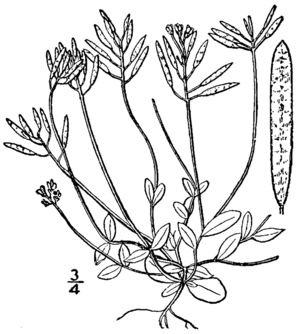Draba reptans facts for kids
Quick facts for kids Draba reptans |
|
|---|---|
 |
|
| Scientific classification | |
| Genus: |
Draba
|
| Species: |
reptans
|
| Synonyms | |
|
|
Draba reptans is a small plant known by many common names. Some of these include Carolina draba, Carolina whitlow-grass, and Creeping whitlow-grass. It is an annual plant, which means it lives for only one growing season.
This plant belongs to the Brassicaceae family. This family also includes many common vegetables like broccoli and cabbage. You can find Draba reptans growing naturally across North America.
Protecting Draba Reptans
The "conservation status" of a plant tells us how much it is at risk of disappearing. Draba reptans faces different levels of risk in various U.S. states. This means efforts are being made to protect it.
- In Connecticut, it is a "special concern" species. This means it needs careful attention to make sure its populations stay healthy.
- It is listed as "threatened" in Michigan, New York, and Ohio. A threatened species means it could become endangered soon if nothing changes.
- In New Jersey, Draba reptans is "endangered". This means it is at a very high risk of disappearing forever.
- It is considered "extirpated" in Pennsylvania. This means the plant no longer grows naturally in Pennsylvania, even though it still exists in other places.
- In Rhode Island, it is listed as "historical". This means it was once found there, but it has not been seen in a very long time.
Traditional Uses of the Plant
Ethnobotany is the study of how people and cultures use plants. For a long time, people have learned about plants and their uses from nature.
The Ramah Navajo people, a Native American group, have traditionally used Draba reptans. They would crush the leaves of the plant to make a soft, moist paste. This paste is called a poultice. They would then apply this poultice to sores on the skin. This was a traditional way to help with skin problems.

